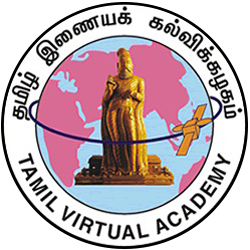This
lesson speaks of ‘Thanjaivaanan Kovai’, a renowned text that falls
under the minor literary genre called ‘Kovai’. Written in the 13th
century A.D. by a poet called Poyyamozhip, Pulavar, this text pertains
to ‘agap porul ilakkiyam’, as it comments on the inner universe
of its protagonists and codifies the behaviour concerning their
love, courtship and marriage. The ‘aga ozhukkam’ of the lover (thalaivan)
and his beloved (thalaivi) forms the subject of this text.
The protagonist or ‘paatudaithalaivan’ of
‘Thanjaivaanan Kovai’ is Thanjaivaanan, the ruler of a small region
called Maarai Naadu which was a part of the Pandya kingdom. Thanjaivaanan
is also known as Chandiravaanan. He was the descendant of the Paanars,
a group of local chieftains who migrated from the Pallava and Chola
kingdoms to the Pandya kingdom. Thanjaivaanan served as the chief
commander of the Pandya army and was the trusted minister of Pandya
King Kulasekaran. The text not only portrays the ‘agam’ life of
Thanjaivaanan but also extols his courage, benevolence and nobility.
It also reveals that he was a great patron of the Tamil language.
‘Thanjaivaanan Kovai’ is based on the ancient
grammar text ‘Nambi Agaporul’. “Nambi Agaporul” is an extensive
treatise on the different aspects of ‘agathinai.’ Agathinai is a
literary convention that prescribes and codifies the emotions, conduct
and behaviour pertaining to love, courtship and marriage. ‘Thanjaivaanan
Kovai’ illustrates the various aspects of agathinai expounded in
“Nambi Agaporul”. Like “Nambi Agaporul”, ‘Thanjaivaanan Kovai’ is
also divided into 3 parts namely, ‘Kalaviyal’, ‘Varaiviyal’ and
‘Karpiyal’. Kalaviyal contains 18 sections and a total of 280 verses.
This section describes the clandestine meeting of the lovers before
marriage. Varaiviyal is divided into 8 sections containing 86 verses.
It deals with ‘varaivu’ or the ceremony of marriage through which
the lovers seek to sanctify their love. There are 7 sections in
Karpiyal and a total of 59 verses. Karpiyal depicts love in the
context of married life. All the verses are set in a metre called
‘Kattalai Kalithurai’.
As ‘Thanjaivaanan Kovai’ is an ‘aga porul’
text, it has all the features unique to ‘agam’ literature. It portrays
characters typically found in ‘agam’ poetry such as the thalaivan,
thalaivi, sevili, nattrai, paangan, paangi, kandor and parathai.
The situations or the ‘aga porul nigazhvugal’ in the text are depicted
through the utterances or ‘kootrugal’ of these 9 characters. ‘Thanjaivaanan
Kovai’ shows an extensive use of poetic devices unique to ‘agam’
poetry such as ‘ullurai uvamam’ and ‘iraichi’. ‘Thanjaivaanan Kovai’
also celebrates the virtues of its protagonist, Thanjaivaanan. He
was an exemplary ruler whose benevolence and generosity won him
the love of his people. We also learn of his extraordinary courage
and valour. He was a great patron of the Tamil.
‘Thanjaivaanan Kovai’ has several literary
merits. Chief among these is the use of figures of speech. The lesson
illustrates the poet’s brilliant use of figures of speech such as
‘uvamai ani’, uruvaga ani’, ‘thanmai ani’ and ‘tharkuripetra ani’.


